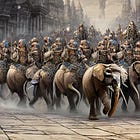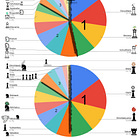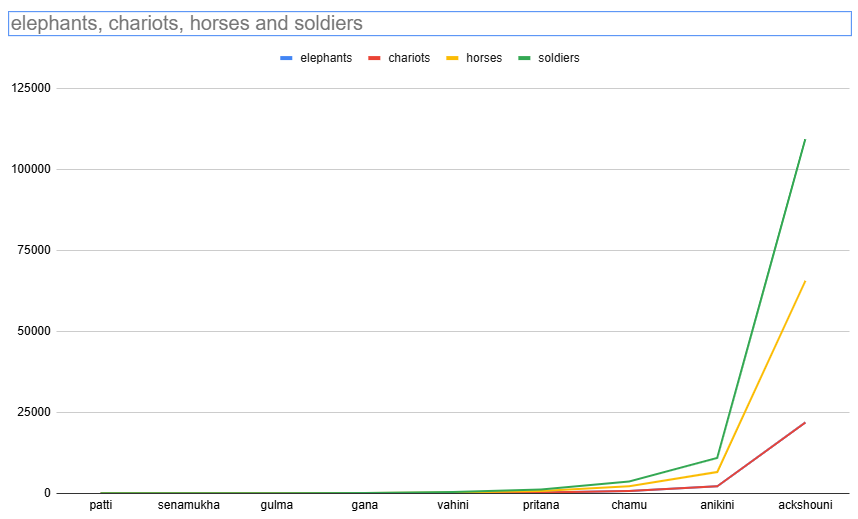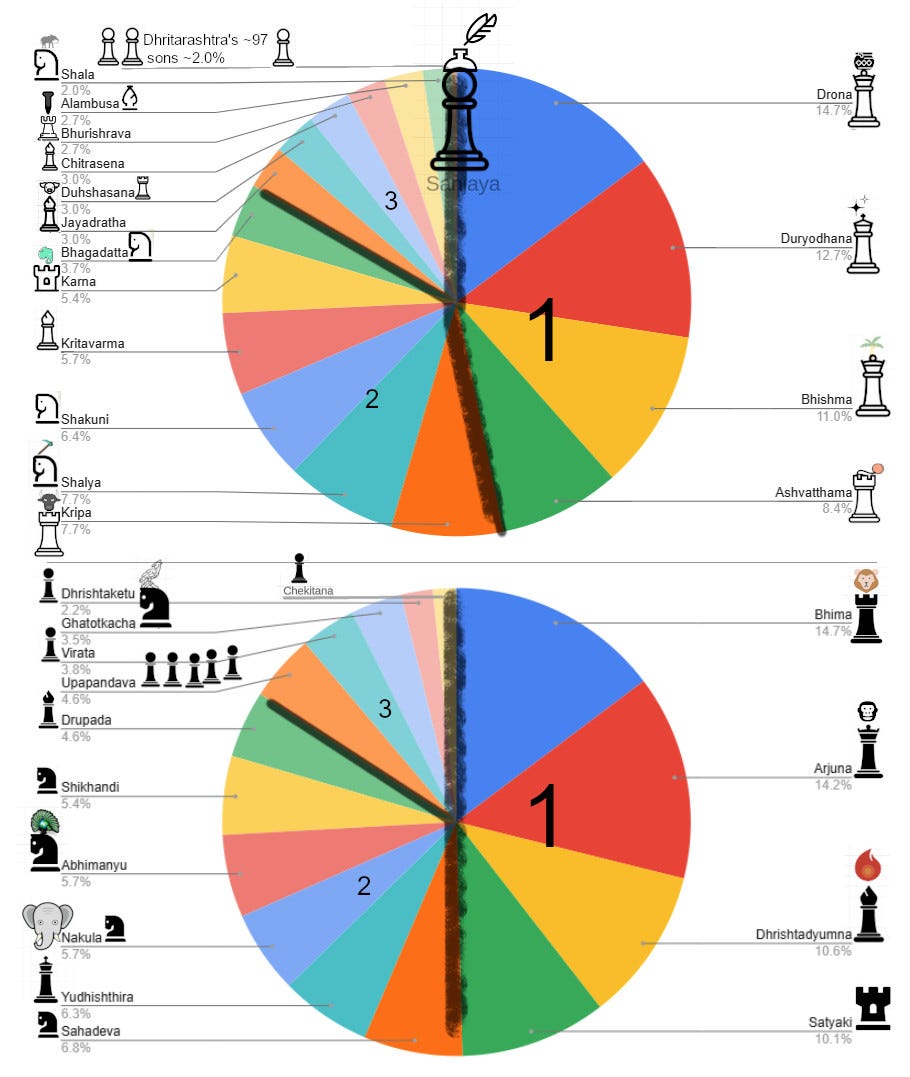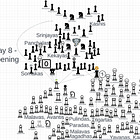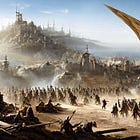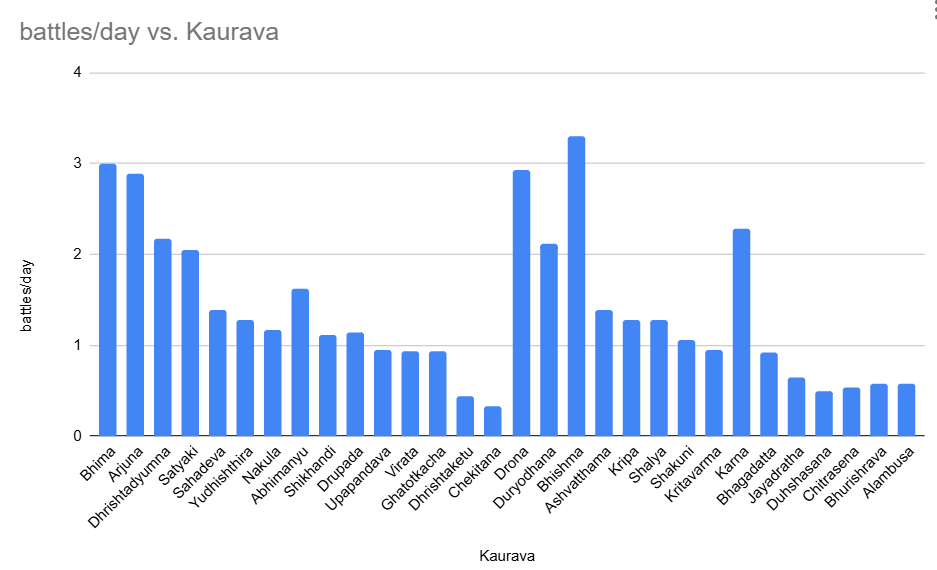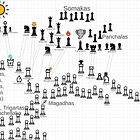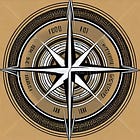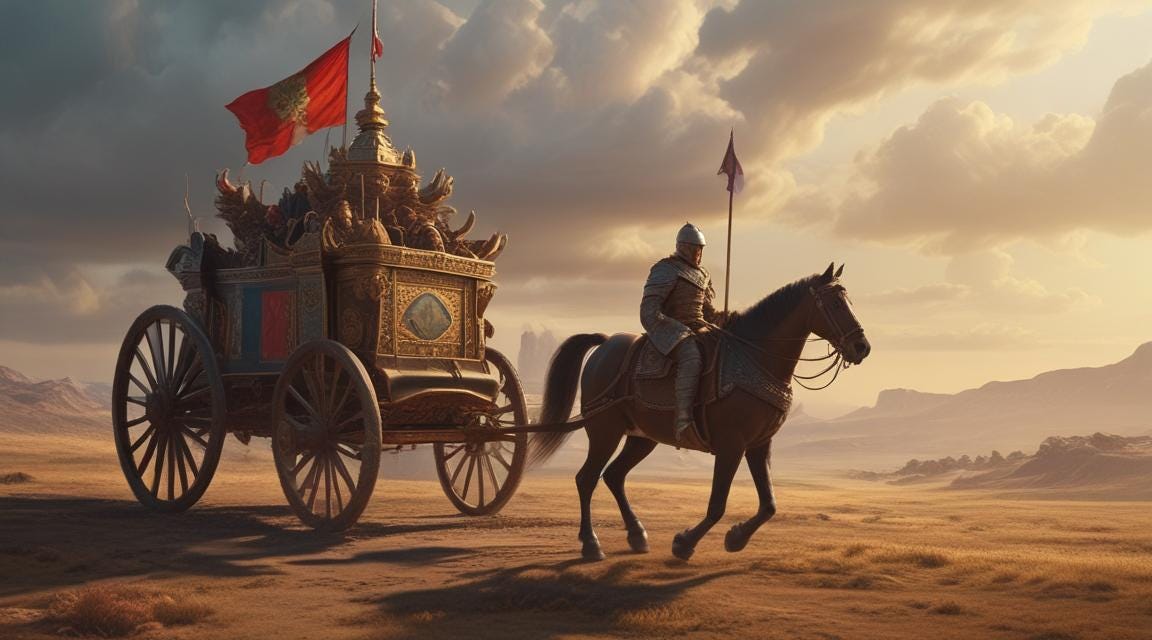Introduction
Part I of this series looked at why military units scale by powers of 3.
Part II derived metrics by events in the Mahabharata’s epic 18-day war.
In Part III we will dig into the graphs from part II and tease out individual analysis to categorize the heroes into tiers and compare performance. The intent of this analysis is to give newcomers who may need help placing the many characters in relative contexts, but also may be of interest to those who know the epic with data driven analytics that may support or challenge their held opinions.
What are we looking at?
Classical beauty.
Mathematical expressions can reflect aesthetical value judgments. Mathematical quantification should demonstrate aesthetics if its measurements are meaningful.
The mirrored pie graphs of warrior war shares substantiate the Mahabharata’s extraordinarily well-crafted structure and balance. Not only are there so many characters to each side, but every character is evenly balanced by a counterpart in ability and coverage.
The magic of the minor characters, what we will categorize as Tier 3 and Tier 4 below, is often that unlike other stories they do not act like minor characters. Every data point is a fully flushed story. Every character acts from self interest. The math demonstrates those value assessments of the material visually.
I & II Recaps
Part I - Powers of Three by Patti
As they say, an army marches on its stomach. In part I we described the scalar functions for calculating numbers of men, elephants, chariots and horses. The basic modular military unit is composed of 1 elephant, 1 chariot, 3 horses and 5 men - also called a patti.
The armies units scale by powers of 3 for 8 steps then by a factor of 10 at the last. the equations are
where N is >= 0 and N <= 7
where M is = [1,3,5] depending on counting chariots & elephants, horses or men.
Let’s plot these functions to see how they scale.
23,000 elephants to feed. That’s a lot of hay! The first seven steps gives an exponential curve and the last step amplifies like -
The last step, akshauhini, multiplies anikini by 10. Akshauhini are the largest tactical units in the war of the Mahabharata.
totals
The Kauravas forces outnumbered the Pandavas 11 akshauhinis to 7.
The Patti may be the basic unit because it describes the minimum constituents needed to create 1 of each unit of the 4 forces in Bronze Age military. These are (1) 1 chariot with 2 horses and 2 men, (2) 1 unit of cavalry, (3) 1 elephant rider and (4) 1 infantry.
Why scale by 3?
A recap on battlefield geometry from part I.
Elephants and horses in battle cannot be kept at a stand-still.
Given the animals must be kept moving, the question is what space can they be directed to move over when an enemy controls territory.
Another challenge is if the animals must be kept moving, and move in a straight line or chaotically, how can one maintain and defend space.
A minimum of three elephants is needed to create a ring where the elephants move continuously in place over the same ground. Chariots and cavalry horses can be kept in motion by circling around the elephants. With two elephants, no such tactic for maintaining territory can be held.
Similarly, at minimum, 3 rings are needed to maintain a larger space by the same triangulation patterns of motion.
With more modules the elephants and horses may be kept moving in more complicated patterns than circles, which begins to touch into the different formations of vyuhas.
Part II character pie shares
The war is fought between the Pandavas and Kauravas.
All the Pandavas and Kauravas are related as Kurus.
Legend
Pandava heroes are black-bottom.
Kaurava heroes are white-top.
Pie shares represent number of battles the hero participated in by count throughout the 18-day war.[1]
Let us turn to the character chariot wheels from Part II to better contextualize the heroes, then plot some hero data.
Tier One - Right Half
Both sides have a big four collective who do almost half of their sides fighting. To know the big 8 gives a good sense of the major players to conflict. Tier One is from 12 o’clock to 6 o’clock on the wheels.
Tier Two - Bottom Left
The second tier in both cases is a group of six supporting heroes found in the lower half in the range from 6 o’clock to 10 o’clock positions in the pie graph. These range from Sahadeva to Drupada on the Pandava side and from Kripa to Bhagadatta on the Kauravas. These fighters are part of several battles and score top tier hero kills.
Tier Three - Top Left
The third tier in both cases are minor characters with a few out-sized moments. Tier Three is the range from quarter to 10 to 5 minutes before midnight.
Jayadratha’s day was day 13.
Alambusa, a cannibal warrior, killed Arjuna’s son Iravan, and was a constant thorn until Ghatotkacha took him out on day 14. In turn, Ghatotkacha took out two more cannibal kings before Karna got him.
The Upapandavas are a composite of five characters - the five Pandavas each have a son through Draupadi. The Upapandavas always fight together and are grouped as one here. The Upapandavas counter-balance Dhritarashtra’s minor sons. The Upapandavas have many nice moments, maybe none bigger than their rescue mission on day 6.
Tier Four - Midnight Riders Wedge
Here is where it gets interesting. The Kauravas and Pandavas have ~dozen(s) of Tier Four characters. In wrasslin’ terms, Tier Four is for ham and eggers. This is the tier of randos, scene stealers and goofballs. That tiny sliver at the top in both wheels is a composite of many minor characters that had only 1 or 2 events - the 11:55 to midnight range on the clockface. These may be colorful bit players, like the all-blue Nila. Count all Dhritrarashtra’s 97 sons after Chitrasena, Duhshasana and Duryodhana in Tier 4 - as well as minor heroes like Chekitana. The characters that come and go. Tier Four fighters have generic names like Kshatradharma or Vinda and Anuvinda. They are peppered through battles as minor combatants that usually die in one or two battles.
Arjuna’s son Iravan is a great Tier Four character, Iravan kills a number of minor kings, including several of Shakuni’s sons, before the cannibal Alambusa takes him down on day 8.
Abhimanyu racks up a large number of Tier Four kills on day 13, including Tier One Duryodhana’s son Lakshmana.
Sums of Tiers
Many of Tier 3 characters are superior fighters than Tier 2 characters during the war, like the softer than soft slice of cream cheese aged Tier 2 archer Drupada. Tier 3 is not less, it’s different. It’s a wildcard bin of loose cannons and shooting stars. Abhimanyu may be a tier 3 character that shot so hot and hard he jumped orbitals into Tier 2.
So… There are about 16 Tier 1-3 characters per side - the same number of pieces per side in a chess game! I really had to wonder is any evidence/chance the Mahabharata may have inspired chess as an adaptation? If chess came about from an attempt to gamify the beloved epic I would not be surprised. 🤔
Recurring 18s
The number 18 shows up in a lot of the math.
There were 18 days in the war.
18 akshauhinis fought in the war.
On average there were 18 events per day with a standard deviation of 18 events.
18 is the median number of warrior battles.
And both sides have about ~18 Top Tier heroes.
Top Tier Hero Kills
though some heroes survive the war, most tier 1-3 heroes are killed by other tier 1-3 heroes in the course of events.
Some plot threads run behind the math
Neither Arjuna nor Bhima, who trained under Drona, could bring themselves to kill Bhishma, Drona or Ashvatthama in battle. Drupada’s family does a lot of damage to the Kaurava’s first tier as the Drupadas hate Drona. Drupada’s sons Shikhandi and Dhrishtadyumna take out the Drona and Bhishma.
Dhrishtadyumna’s hatred of Drona stems from the time when Drona took all the young Kaurava princes he trained and conquered Drupada and took the better half of Drona’s Panchala kingdom. The story of Drupada and Drona’s enmity is told in Sambhava.
On day 15 Drona ended the cat and mouse games with his old frenemies Drupada and Virata before going down himself to Dhrishtadyumna. Arjuna and Dhrishtadyumna almost fight after Dhrishtadyumna beheads an unarmed, meditating Drona.
I gave Ghatotkacha two counts for the cannibal kings he killed on night fourteen - clear tier 4 characters - but after Ghatotkacha beheaded the cannibals he threw their heads onto tier 1 Duryodhana’s chariot, so…
Satyaki killed Kritavarma many years after the war, but the two were drinking and arguing about the war when the fight broke out. Satyaki is killed right after he beheads Kritavarma for calling him out about how Bhurishrava went down. Satyaki argues back about Kritavarma’s role in the five Upapandavas, Dhrishtadyumna and Shikhandi. Nonetheless I credited Satyaki with Kritavarma, though technically it took place well after the 18-day war.
I gave full credit to Arjuna and Satyaki for Bhurishrava (and the four Kauravas for Abhimanyu). Should a hero get a half credit for multiparty kills like football sacks? We may be venturing into back of the baseball card dork stats territory here, so I’ll leave it to the homeschool homies to compile counts for number of arrows each hero shot off by day.
Cherry Picket Fence Stats
Obviously the longer a character survives in an epic war, the more battle shares they can compile. That thought yields average battles per day by warrior.
Pandavas run from Bhima to Chekitana. The Kauravas are Drona to Alambusa.
Arjuna and Bhima stand out for their pace - they average an astonishing 3 feats per day for all 18 days! Imagine fighting three times a day like breakfast, lunch and dinner every day. For context, heroes averaged 1.3 battles a day with a standard deviation of .832. So Arjuna and Bhima are 2-3 standard deviations from the average epic hero in their daily fight activities.
However! The old lions Drona and Bhishma matched or significantly bettered Arjuna and Bhima’s pace before they met their ends on days 15 and 10, respectively.
Where is Karna?
Karna gets a lot of hype, but Karna’s reputation is not always supported by the data.
We see Karna live up to his reputation in the avg. battles per day metric - Karna may have sat out the first 10 days of war carrying on a feud with General Bhishma, but when Karna entered the fray he stayed busy.
However, not so fast! - Karna survived the fewest days of any hero that died, so Karna gets demerits for longevity. On average tier 1-3 heroes survived 16 days with a standard deviation of 3 days, so Karna surviving for just 7 days makes his longevity rank very below par.
Don’t let the Karna stans fool you - Karna is a quintessential major-minor Tier 2 hero; interesting, great in some ways but flawed or limited and does not quite stack up to Tier 1 heroes. The elder Pandava is the runt of the litter by the math.
Kings Defenses
Duryodhana was many things but a coward to challenge with, ‘let’s you and him fight!’, Duryodhana was not. Duryodhana is at the top of the volume and activity boards. Say what you will about his character, but King Duryodhana fought long and hard. This is favorable as compared to the performance of his small slice brother Duhshasana, who seemed to find a risk averse back way to the rear guard while others fought.
Yudhishthira, Nakula and Sahadeva are overlooked for Bhima and Arjuna, but they are far from worthless or passive heroes. By battle count metric those three did the largest share of the Pandavas’ fighting after the tier 1 champions Arjuna and Bhima, General Dhrishtadyumna and Arjuna’s right-hand man Satyaki.
Sahadeva and Nakula by the war were aged and no longer as quick or effective as they were in their primes for Digvijaya during the Pandavas rise, but they were still major players.
Breakdown - Final Analysis
Part of the mission here is to make the enormity of the epic digestible for newcomers and I hope this speaks to that. If the number of characters and who matters may seem daunting to follow - it is, especially when one starts with all the alternative names each hero characters as a consequence of their exploits.
The juice is worth the squeeze.
For newcomers to the epic, I hope breaking the heroes down into meaningful groups based on activity and relative importance helps form handles to grasp.
There may be something in this for old heads too. Are you a Karna stan? I know of at least one case where an individual’s perception that Yudhishthira and the twins were ‘worthless’ in battle was rejigged by this data.
Foot Notes
[1] Standards Rundown
Arjuna’s standard is Hanuman. Bhima’s standard is a lion. Abhimanyu’s standard is a peacock. Shalya’s standard is a plow and Shala’s standard is a silver elephant. Kripa’s standard is a bull. Ghatotkacha’s standard is a chariot wheel, but a giant king of vultures follows him around and sits on top of his flagpole. Drona’s standard is a water pot and Drona was born in a pot. Karna’s standard is an elephant. Ashvatthama’s standard is a lion’s tail. Dhrishtadyumna’s standard is a flame. Bhurishrava’s standard is a stake. Jayadratha’s standard is a silver boar. Yudhishthira’s standard is a moon and stars, but during the war he is often surrounded and protected by elephants and the elephant looked cute, so …
Why the (goofball) Iconography?
Now - may laugh at the chess piece callouts for the warriors. sure ok hehe. - posts like this are chipping away at creating an accessible version of the epic for an audience that may not be of the culture or familiar with the source material at all but interested.
The challenge is to compress the complexity and rich tapestry of its characters and conflicts. The use of a symbol may help meaningfully describe the character. I used chess pieces, which carry relative weights, because chess originates from India, so it aligns culturally. To repeat the relative chess piece power Queen>Rook>Knight>Bishop>Pawn. The intent is to convey the relative strengths of the warriors with pieces they are assigned.
The symbols over the chess pieces reference the character’s flag standard that flies over their chariot.
e.g.
Bhishma’s standard is a palm tree. But don’t let that Hawaiian print tiki bar cocktail standard fool you, The Grandfather is an ice-cold queen!
The point is - if you were wondering - yes the symbols hanging over the chess piece characters reference meaning from the text. These are their standards. [1]

